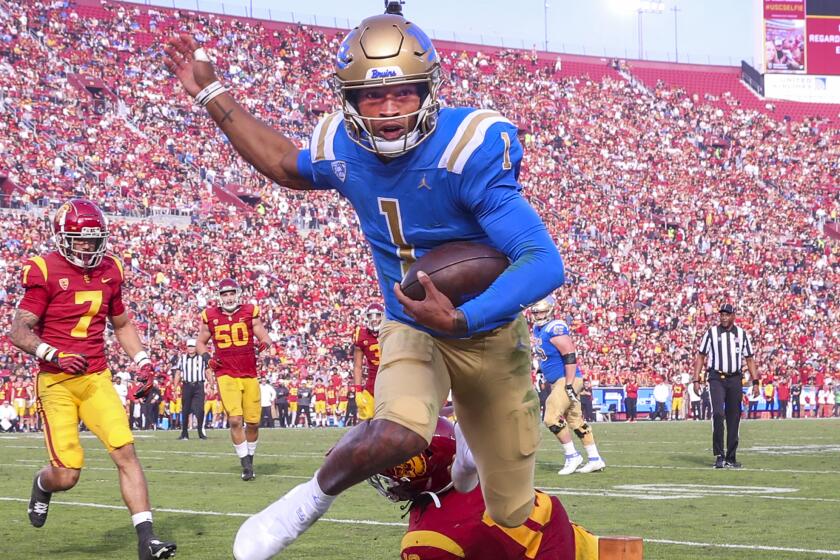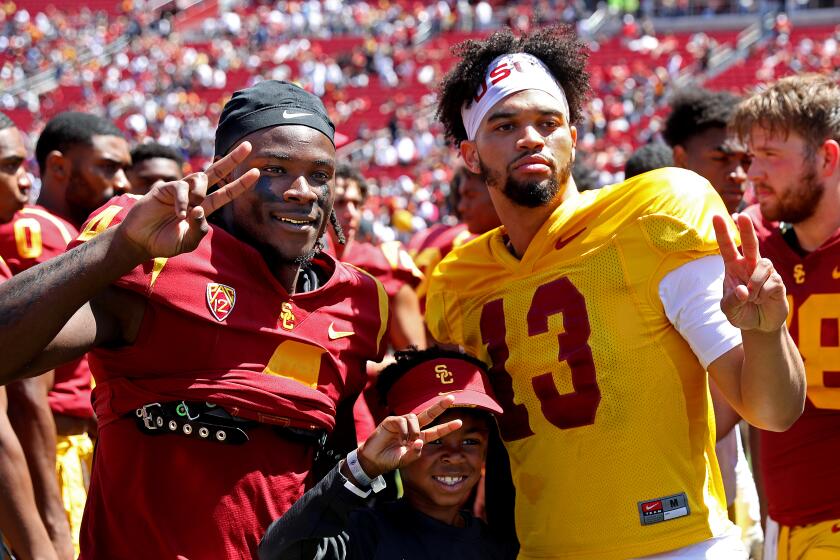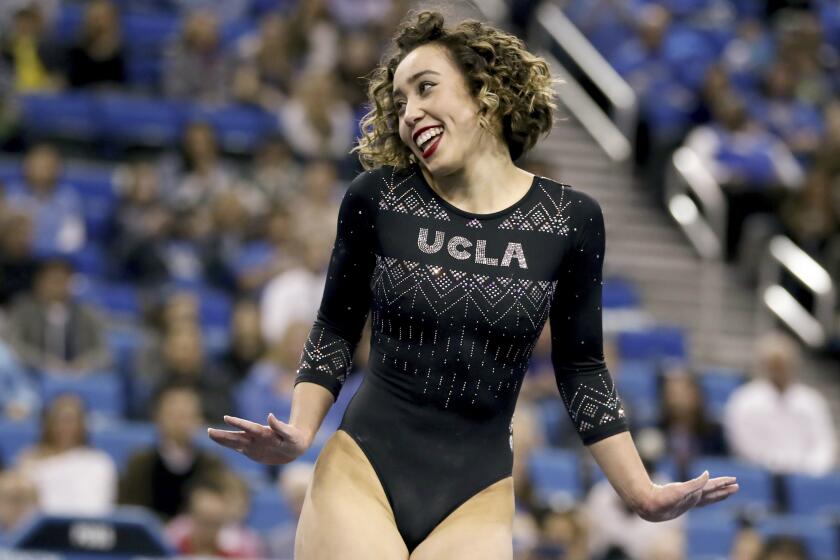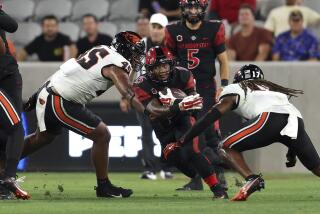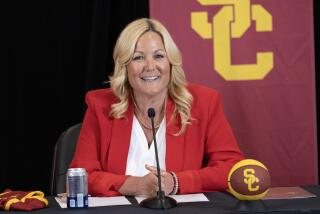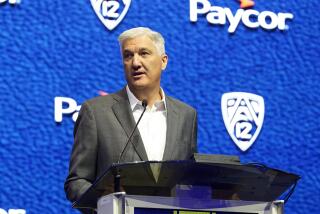Did Larry Scott kill the Pac-12? The answer is more complicated than you might think
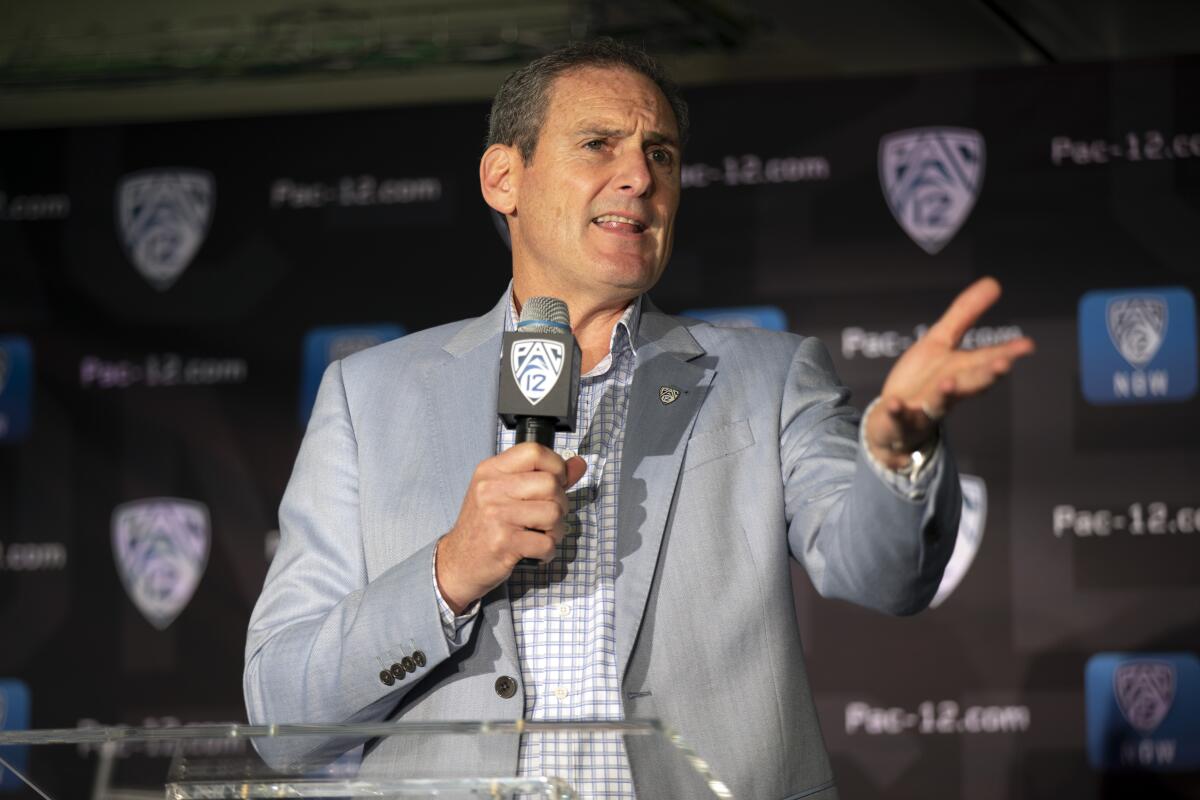
- Share via
The anger was immediate, arising just minutes after news broke that USC and UCLA were headed for the Big Ten Conference. Fans tapped out posts on social media, one after another, invoking the name of Larry Scott.
A year had passed since the former Pac-12 commissioner stepped down, yet people blamed him for the loss of two marquee programs. They labeled him “destructive” and “a fraud,” predicting that business schools would someday teach about his “leadership failures.”
Larry Scott single-handedly destroyed the Pac-12, they wrote.
This vitriol emanated from a decision Scott made shortly after taking charge in 2009. At a time when other Power Five conferences were partnering with ESPN and Fox to launch dedicated networks — deals that would generate billions of dollars — Scott persuaded his universities to roll the dice.
The Pac-12, he insisted, should build its own network. The venture might need time to gather momentum, but it would allow the conference to keep all the control, all the profits.
“If we do this right,” Scott recalled telling his university presidents, “it will be successful.”
His gamble never paid off. A decade after their debut, the Pac-12 Networks have yet to gain widespread traction, the conference falling well behind its rivals in annual revenue and struggling to win on a national level in the all-important sports of football and men’s basketball.
USC and UCLA are leaving the Pac-12 for the Big Ten, a shift that will move college football’s ‘Power Five’ closer to a ‘Power Two.’
“It’s easy now to take shots at Larry Scott and play armchair quarterback,” said Patrick Rishe, director of the sports business program at Washington University in St. Louis. “That being said, I think history will show he did not make the wisest decision.”
Which raises the question: With USC and UCLA departing, with speculation about Oregon, Washington and Stanford soon to follow, how much of the blame does Scott deserve?
::
His hiring looked like a savvy move for a conference lagging in revenue and national reputation. It made sense to bring aboard an outsider who had proved his marketing skills as head of the Women’s Tennis Assn.
Scott, who did not respond to an interview request for this story, knew what he was getting into.
“That was my challenge,” he said in 2010.
The new boss rang the opening bell at NASDAQ and ran a promo in Times Square, saying: “We have an obligation to promote our product as broadly as we can.” He added two schools, Utah and Colorado, through expansion and unveiled a revamped logo.
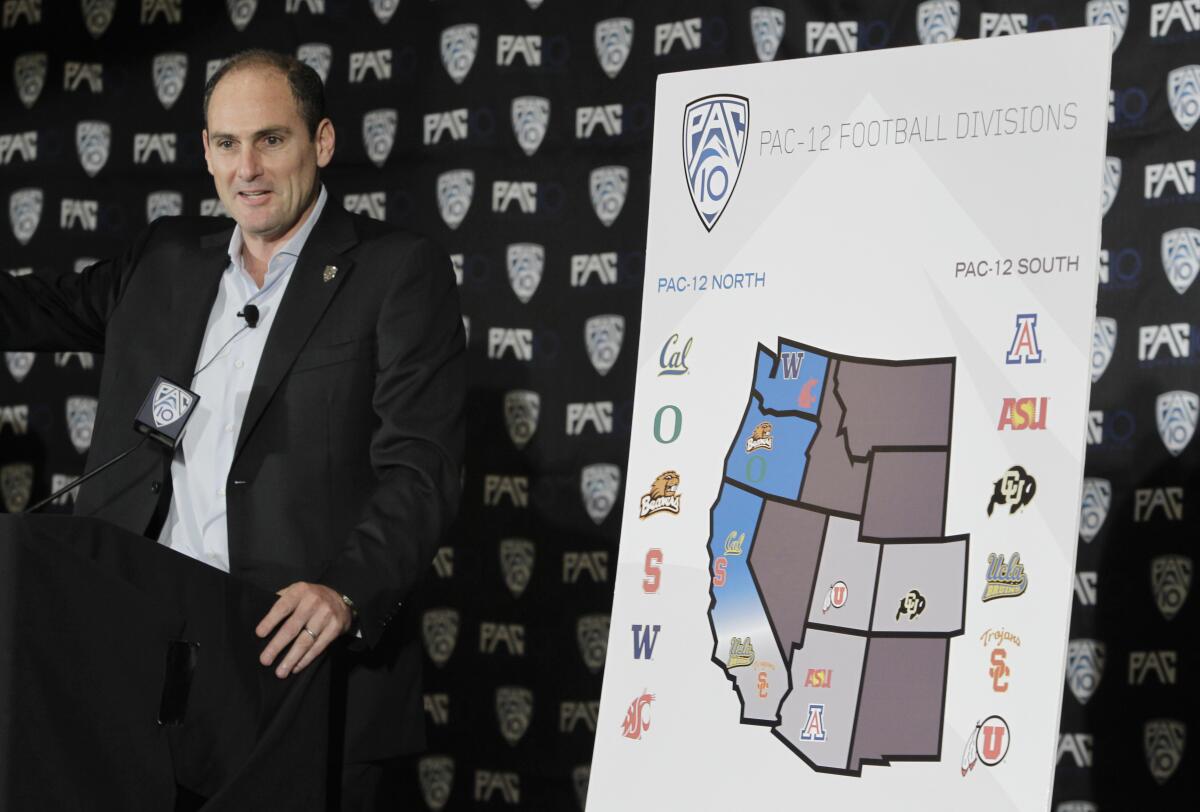
Television dollars were altering the business of college sports. The Big Ten had partnered with Fox to launch its network in 2007 and the SEC was handing its channel over to ESPN in exchange for a massive rights fee. CBS, ESPN and others expressed interest in the Pac-12.
“One criticism I’ve heard about Larry Scott in the industry is that he always wants to be the smartest guy in the room,” Rishe said. “You wonder if he tried to out-think this one.”
Money and equity were only part of the argument for going it alone. The Pac-12 had always considered itself the “Olympic” conference, winning national titles in sports such as swimming, volleyball and water polo. An established broadcaster might focus too narrowly on football and men’s basketball; a self-owned network would ensure these sports received proper exposure.
The Pac-12 Networks launched in 2012 with a national channel and six regional channels, which Scott characterized as an effort to “super-serve fans” in various geographic markets. Scott also worked a historically lucrative side deal, selling a chunk of football and men’s basketball games to ESPN and Fox for $3 billion over 12 years.
That money, he believed, would give his network some cushion to establish itself.
Though the market was crowded — so many sports channels jumping into the fray — the Pac-12 asked carriers for a reported 80 cents per subscriber, more than CNN, USA or FX. Time Warner Cable agreed but negotiations with DirecTV proved more difficult.
“One criticism I’ve heard about Larry Scott in the industry is that he always wants to be the smartest guy in the room. You wonder if he tried to out-think this one.”
— Patrick Rishe, director of the sports business program at Washington University in St. Louis
Scott acknowledged that distribution would be crucial.
“I know there’s a lot of anxiety,” he said in 2012. “It’s understandable … it matters a lot.”
::
Three years into his big gamble, during the 2014 Pac-12 football media days in Los Angeles, Scott took a break from the proceedings to find a shady spot outside. Speaking with a reporter, he preached patience.
“You have to look at this based on where we’ll be after 10 years,” he said. “Not three.”
The early returns were not promising.
Still unable to secure a DirecTV deal, the Pac-12 was reaching only 11 million paying subscribers compared to 57 million for the Big Ten. With the SEC set to relaunch to a predicted 67 million households, Scott told his university presidents “we have to look at the benefits long-term.”
Though the ESPN and Fox deals were lucrative, the cable networks demanded nighttime kickoffs to fill empty airtime on the East Coast. Fans and coaches grew frustrated with the “Pac-12 After Dark” games.
USC and UCLA’s decision to join the Big Ten in 2024 will make a significant impact in the college sports world. Here’s a breakdown of what the move means.
Beyond that, Scott’s project hit a stretch of bad luck.
NCAA sanctions hurt USC football more than expected and Oregon lost coach Chip Kelly to the NFL. None of the top men’s basketball programs could reach the Final Four.
The conference found itself in a Catch-22. Its network needed a juggernaut team to lure viewers but, with rival conferences generating larger revenues, spending more on coaches and lavish training facilities, competing for top recruits grew tougher.
“They had a lot of product, but they didn’t have the level of audience they needed,” said Daniel Durban, director of USC’s Institute of Sports, Media and Society. “Frankly, the Pac-12 just wasn’t that compelling.”
Meanwhile, the SEC was pouring unprecedented resources into football, with Nick Saban and Alabama leading the way, racking up one championship after another.
“The Pac-12 schools have always been on the West Coast, they’ve always dealt with visibility and recruiting issues,” Rishe said. “Those issues become more acute once a conference like the SEC takes over and it becomes harder to catch up.”
The Olympic sports could not compensate.
“The Olympic thing can be icing on the cake,” Durbin said. “But you need the core product.”
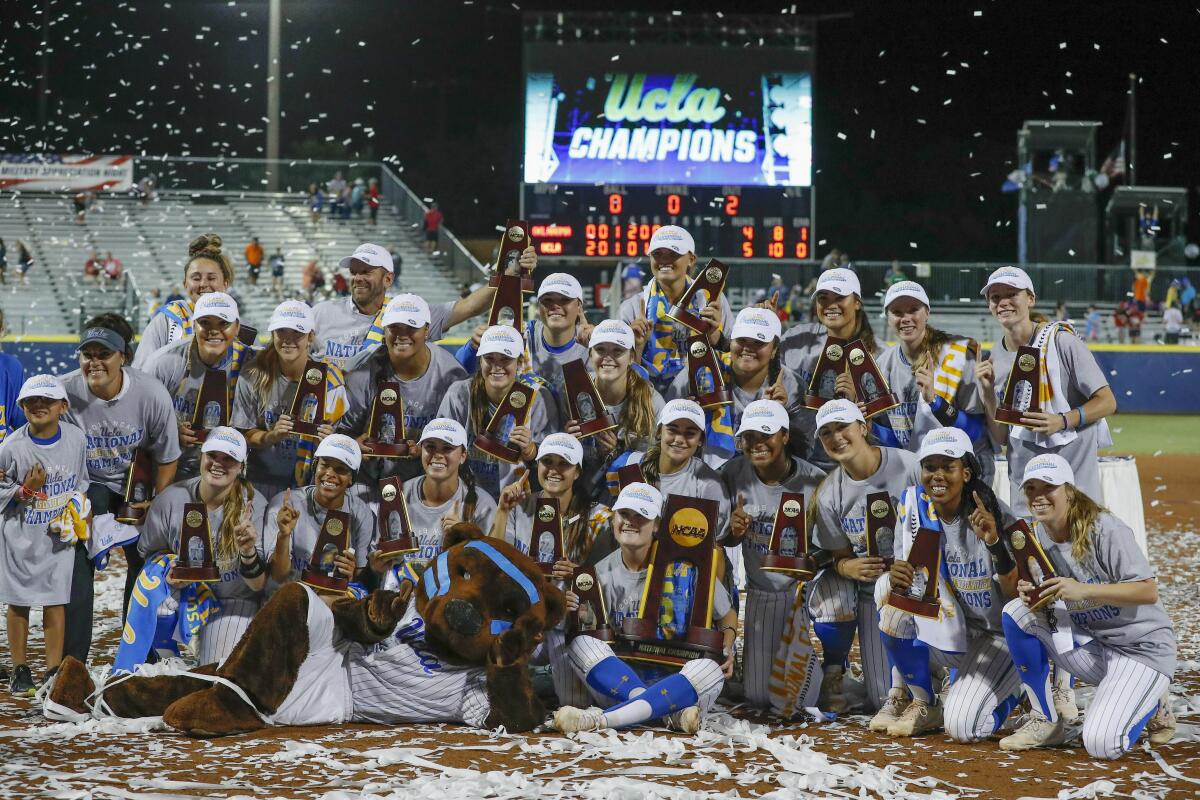
::
The numbers remained lukewarm through 2018, the Pac-12 distributing about $30 million a year to its schools, well behind the $40 million-plus the SEC was paying out. Washington State president Kirk Schulz and others began to complain publicly.
That summer, sitting in the stands at an AAU basketball tournament in Garden Grove, watching his teenage son play, Scott held fast.
“I would never say that you wouldn’t make a different call at some point,” he said. “But at this point there’s been a real conviction by our universities and myself that the original purposes of having a Pac-12 network are important.”
ESPN reportedly offered to distribute the network in exchange for an extended rights agreement. No deal was made.
“If that was the case, it was a substantially missed opportunity,” consultant Lee Berke, president of LHB Sports, Entertainment & Media Inc., said. “There is definitely room for criticism.”
At roughly the same time, Scott’s annual salary had risen well above $4 million, making him the highest-paid commissioner, according to USA Today. Pac-12 university presidents finally lost patience after the 2020 football season, when it was announced that Scott would step down in June, a year before the end of his contract.
“At one point, our television agreement was the most lucrative in the nation and the debut of the Pac-12 Networks helped deliver our championship brand to U.S. and global markets on traditional and digital platforms,” Oregon president Michael Schill said in a statement. “That said, the intercollegiate athletics marketplace doesn’t remain static and now is a good time to bring in a new leader who will help us develop our go-forward strategy.”
“Larry Scott is one of the issues, ... [But] you can’t scapegoat just one person.”
— Daniel Durban, director of USC’s Institute of Sports, Media and Society
Their strategy becomes more difficult with current media contracts expiring in 2024 and two, if not five, marquee programs headed out the door.
This exodus can be linked to Scott’s gambit. The Big Ten distributed $680 million to schools in the 2021 fiscal year, almost double the $344 million paid out by the Pac-12. Without additional revenue, UCLA officials said they were at risk of cutting programs. USC president Carol Folt called the Big Ten move a benefit to her school’s “long-term success and stability.”
So where does that leave Scott and his 11-year tenure?
Certainly he must take responsibility for leading the Pac-12 down the path to self-ownership and signing that 12-year ESPN-Fox deal that left the conference unable to adjust to a changing media environment. Also, for failing to shift course in other ways.
“Remember, when he came onto the scene, he was trying to make a splash,” Rishe said. “There was obviously some myopia.”
Some factors were beyond his control.
Three years removed from the gymnastics routine that made her a viral sensation, Katelyn Ohashi has used her emotional journey to help others.
Experts point to that run of bad luck, the cyclical nature of college sports and the university presidents who signed off on Scott’s media strategy at the start. Once the network launched, campus leaders declined to spend at SEC levels and foster winning teams that would draw more viewers.
The conference also faced an uphill battle in terms of geography and time zones, with a majority of television viewers residing in distant regions of the country.
“Unless you took the Pac-12 and moved it across the Mississippi River, you’re always going to have those problems,” Berke said. “Essentially, that’s what the Big Ten has done, they’ve taken USC and UCLA and moved them into the central and eastern time zones where a lot more of their games are going to be seen.”
Shortly before stepping down, Scott told the Associated Press he lamented his schools not winning more in football. He criticized university leadership for abandoning his plan too soon.
Fans did not react kindly to the comments. Still, the final verdict on his tenure is probably more nuanced than a slew of angry posts on social media might suggest.
“Larry Scott is one of the issues,” Durbin said. But when it comes to something as big as the potential implosion of the Pac-12, he added, “you can’t scapegoat just one person.”
More to Read
Go beyond the scoreboard
Get the latest on L.A.'s teams in the daily Sports Report newsletter.
You may occasionally receive promotional content from the Los Angeles Times.

